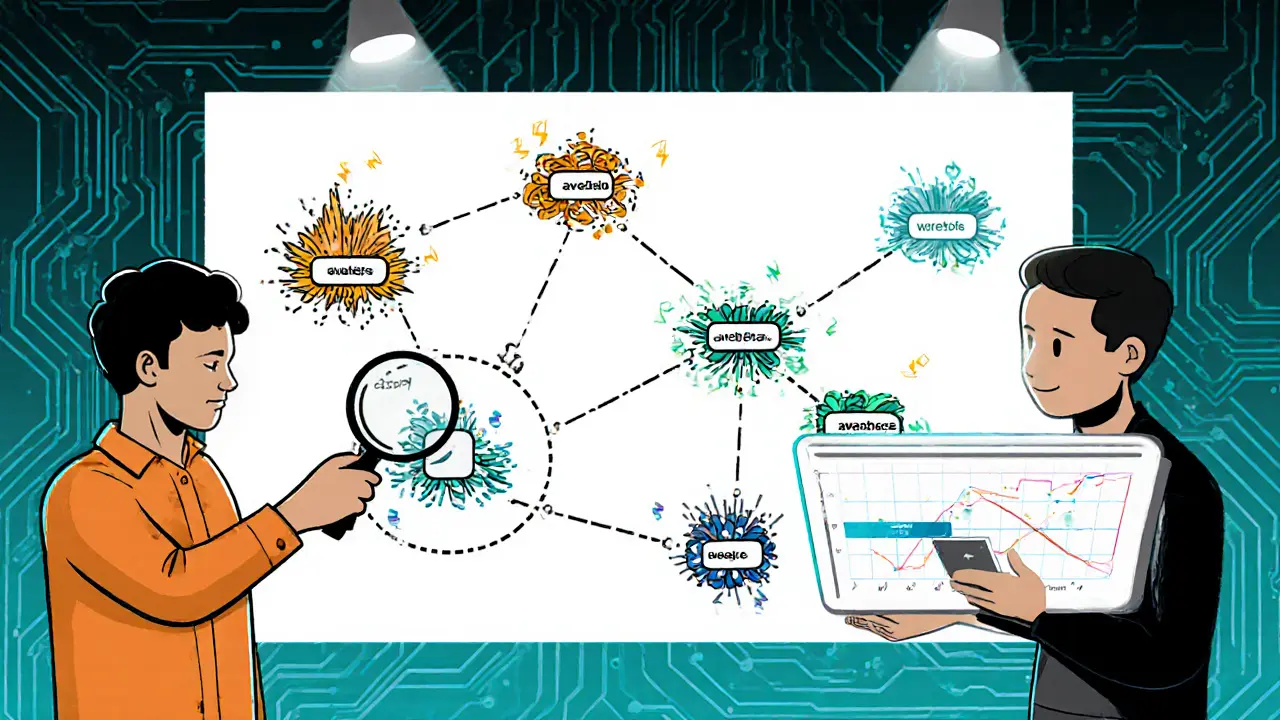North Korean Crypto Transaction Detector
Transaction Analysis Parameters
Enter transaction details and click "Analyze Transaction Pattern" to check for potential North Korean crypto activity indicators.
When you hear about a massive crypto heist, the headlines usually focus on the dollar amount, not the nation behind it. In reality, the North Korean crypto transactions represent a sophisticated, state‑sponsored money‑laundering operation that spans Ethereum, Bitcoin, Binance Smart Chain and dozens of other networks. Detecting these flows isn’t a hobbyist pursuit; it requires the kind of forensic tooling that only a handful of blockchain intelligence firms provide.
North Korean cryptocurrency transactions are illicit digital‑currency movements originating from threat groups linked to the Democratic People’s Republic of Korea (DPRK). They typically start with a hack, funnel stolen assets through cross‑chain bridges, and end up in mixers or over‑the‑counter (OTC) venues that obscure the final beneficiary.
Why the DPRK’s Crypto Campaign Matters
Between 2017 and 2023 the regime siphoned roughly $3billion in crypto, according to multiple government and private investigations. The February2025 breach of the Bybit exchange alone accounted for $1.5billion in stolen Ethereum - the single largest crypto theft ever recorded. These funds finance missile development, cyber‑espionage units and the country’s broader sanctions‑evasion strategy. For regulators and exchanges, missing a single transaction can mean a multi‑billion‑dollar loss and a blow to global financial stability.
Core Detection Methodologies
Modern blockchain intelligence hinges on three pillars: address clustering, transaction‑pattern analysis, and cross‑chain monitoring.
- Address clustering: By linking on‑chain behaviors (e.g., reuse of input addresses, timing of transfers) analysts group wallets that likely belong to the same actor.
- Pattern recognition: North Korean operators favor “flood‑the‑zone” bursts - high‑frequency, low‑value moves across dozens of addresses to overwhelm compliance alerts.
- Cross‑chain tracing: Funds often jump from Ethereum to Binance Smart Chain or Solana via bridges before being swapped into Bitcoin, demanding simultaneous monitoring of multiple ledgers.
Each pillar feeds into visual tools like Chainalysis Reactor graphs, which render complex flows into digestible nodes and edges.
Key Players in Blockchain Intelligence
The two firms most cited for DPRK tracking are TRM Labs and Chainalysis. Both maintain proprietary databases of malicious addresses, but they differ in focus.
- TRM Labs excels at longitudinal analysis of cross‑chain bridges and “flood‑the‑zone” transaction bursts. Their reports emphasize how North Korean groups have shifted from classic mixers (e.g., Tornado Cash) to speed‑oriented automation.
- Chainalysis offers real‑time visualization via Reactor, allowing analysts to slice a breach into phases: initial compromise, bridge conversion, mixer obfuscation, and final liquidation.
Case Study: The Bybit Hack (February2025)
The Bybit exploit illustrates the full detection lifecycle. Within hours of the breach, TRM Labs flagged a surge of ERC‑20 tokens moving to the Binance Smart Chain, then crossing to a Solana address that immediately swapped the assets for Bitcoin on a decentralized exchange.
Chainalysis’ Reactor map highlighted three crucial waypoints:
- The “initial theft” wallet on Ethereum (address A).
- A chain‑bridge transaction to Binance Smart Chain (address B) occurring at a 3‑second interval.
- A final hop into a Bitcoin CoinJoin service (address C) before the funds vanished into an OTC desk.
Both firms converged on a single attribution: the address patterns matched those previously linked to the “TraderTraitor” cluster, a known DPRK unit.

Case Study: DMM Bitcoin Exploit (2024)
The Japanese exchange DMM suffered a loss of 4,502.9Bitcoin (≈$305million). The attack used a standard mixing service - in this case, YoMix - before funneling the coins through the Huione Guarantee marketplace in Cambodia, a known conduit for DPRK‑linked laundering.
TRM Labs traced the flow across Ethereum, Binance Smart Chain, and finally into a cross‑chain bridge that converted the assets into a stablecoin, a step that illustrates the regime’s evolving preference for speed over anonymity.
Comparative Overview: TRM Labs vs. Chainalysis
| Feature | TRM Labs | Chainalysis |
|---|---|---|
| Primary focus | Cross‑chain bridge tracking & flood‑the‑zone detection | Real‑time visual graphing (Reactor) |
| Supported networks | Ethereum, Bitcoin, BSC, Solana, Polygon, multiple L2s | Ethereum, Bitcoin, BSC, Solana, Ripple, Stellar |
| Mixing service detection | High accuracy for legacy mixers (Tornado Cash, YoMix) | Moderate; relies on address clustering |
| Alert latency | 30‑60minutes for high‑volume bursts | Near‑real‑time (seconds to minutes) |
| Reporting style | Long‑form threat intel reports | Dashboard widgets & API feeds |
Implementing Detection Inside Your Organization
Adopting a DPRK‑detection stack requires three practical steps.
- Choose a primary intelligence provider. Evaluate based on supported networks, alert speed, and the depth of address‑clustering algorithms. For most exchanges, a hybrid approach - TRM Labs for cross‑chain insights and Chainalysis for live dashboards - offers the best coverage.
- Integrate on‑chain monitoring via API. Pull real‑time alerts into your SIEM or compliance platform. Set thresholds for “flood‑the‑zone” patterns: e.g., more than 50 transactions under 10seconds targeting the same bridge.
- Establish an incident‑response playbook. When an alert fires, analysts should:
- Validate the address cluster against known DPRK tags.
- Map the flow using Reactor or a similar graph tool.
- Contact the relevant exchange or OTC desk to freeze outbound transfers.
Training is essential. Even seasoned analysts can miss subtle variants of the “flood‑the‑zone” technique, where attackers deliberately scatter low‑value transfers to bypass volume‑based rules.
Emerging Trends & Future Outlook
As sanctions tighten, DPRK groups are experimenting with predictive analytics of their own. Early indicators suggest they will target crypto‑ETF providers and DeFi lending platforms, hoping to extract fees directly from smart contracts.
On the defense side, firms are piloting AI‑driven pattern recognition that flags anomalous cross‑chain bridge usage before funds reach a mixer. The goal is not just to react but to pre‑emptively block the conversion step.
Finally, regulatory bodies are drafting mandatory reporting standards for large crypto transfers. Once in place, these rules could provide a legal hook for freezing DPRK‑linked assets before they disappear into OTC markets.
Key Takeaways
- North Korean crypto thefts have surpassed $3billion; detection is a critical security priority.
- TRM Labs and Chainalysis dominate the intelligence market, each with unique strengths.
- Effective detection combines address clustering, flood‑the‑zone pattern alerts, and cross‑chain bridge monitoring.
- Implement a layered response: choose a provider, integrate alerts, and run a defined playbook.
- Stay ahead of evolving tactics by adopting AI‑enhanced analytics and monitoring upcoming regulatory changes.

Frequently Asked Questions
How do TRM Labs and Chainalysis differ in detecting DPRK activity?
TRM Labs focuses on long‑term cross‑chain bridge analysis and identifies the high‑frequency “flood‑the‑zone” bursts typical of North Korean operators. Chainalysis, by contrast, provides near‑real‑time visual graphs (Reactor) that map each step of a breach, making it easier to spot immediate red flags.
What is the “flood‑the‑zone” technique?
It is a DPRK‑specific laundering method where attackers generate a rapid series of low‑value transfers across dozens of wallets and multiple chains. The volume overwhelms compliance tools, making each individual transaction appear innocuous.
Can I detect DPRK transactions without a paid intelligence service?
Open‑source block explorers and community‑maintained blacklist repositories can provide basic coverage, but they lack the depth of address clustering and cross‑chain correlation that paid platforms offer. For high‑risk institutions, using a commercial provider is strongly advised.
What role do mixers like Tornado Cash play in DPRK laundering?
Mixers scramble transaction histories, making it harder to trace funds. However, North Korean actors have started to favor faster bridge‑based conversions over traditional mixers because law‑enforcement pressure has increased around services like Tornado Cash.
How soon after a hack should I expect an attribution to DPRK?
Attribution can happen within days if the attack follows known DPRK patterns. The Bybit case saw FBI and TRM Labs public attribution within 48hours of the breach.












People Comments
While the technical description of the detector interface is thorough, it omits a critical assessment of false‑positive rates, which can overwhelm compliance teams if not calibrated properly. In practice, the “flood‑the‑zone” heuristic often flags benign airdrops, leading to unnecessary investigations. Moreover, the sample code mistakenly uses assignment instead of comparison in the interval check, which could generate misleading alerts. A robust implementation should incorporate configurable thresholds and an explicit verification step before flagging. Finally, the documentation would benefit from a discussion of regulatory considerations, especially concerning sanctions‑evading entities.
The philosophical underpinning of detecting state‑sponsored illicit finance rests on the premise that patterns reveal intent. When actors repeat the same low‑value, high‑frequency bursts, they betray an operational doctrine that transcends individual hack events. Thus, even without a known address, the temporal signature becomes a fingerprint of strategic behavior. The article captures this nuance, yet it could expand on how adaptive adversaries might randomize intervals to evade the very models discussed.
Great overview! 😊 Remember, the key is to set your alert thresholds low enough to catch the bursts but high enough to avoid noise. A quick tip: tag suspicious clusters with a custom label in your SIEM so analysts can filter them instantly.
The piece does a solid job, but the language could be simpler. Not everyone knows what a "cross‑chain bridge" is, so a brief definition would help. Also, saying "DPRK" without context can confuse readers new to the topic.
The methodology outlined demonstrates a comprehensive multi‑layered approach to cyber‑financial forensics, integrating address clustering algorithms, high‑frequency transaction pattern detection, and cross‑chain bridge analytics. By leveraging longitudinal data streams, the system can distinguish between stochastic market activity and orchestrated laundering campaigns characteristic of the DPRK threat actors. Moreover, the utilization of heuristic thresholds for "flood‑the‑zone" activity provides a quantifiable metric that can be calibrated against baseline network traffic. The inclusion of both TRM Labs and Chainalysis as complementary intelligence sources underscores the necessity of heterogenous data fusion to mitigate blind spots inherent in single‑vendor solutions. It is noteworthy that the framework advocates for real‑time alert ingestion via API into organizational SIEM platforms, thereby facilitating automated response playbooks. The procedural directive to map suspicious flows using visual graphing tools, such as Reactor, aligns with best practices for investigative triage. Additionally, the recommendation to establish incident‑response protocols, including verification of address clusters against known DPRK tags, enhances operational resilience. The article could further benefit from a discussion on false‑positive mitigation strategies, perhaps employing machine‑learning classifiers trained on labeled transaction datasets. Finally, the forward‑looking commentary on AI‑driven predictive analytics anticipates an evolution in adversarial tactics, signalling the importance of continuous model retraining. Overall, the exposition provides a robust scaffold for institutions seeking to augment their AML capabilities against state‑sponsored crypto laundering.
This guide is a solid starting point for teams new to blockchain AML. One practical tip: when you see a burst of sub‑$100 transactions across 30 addresses, flag it and run a quick cluster analysis. Often those clusters tie back to known mixers or bridge contracts.
Wow, the drama of a $1.5 billion heist is almost cinematic! 🎬 The way the article breaks down the stages-initial breach, bridge hopping, mixer obscuration-reads like a thriller. It really drives home how sophisticated these actors have become. If you’re not watching the pipelines, you’ll miss the plot twists.
It’s infuriating that these rogue regimes keep draining resources from honest citizens worldwide. We need stricter enforcement, not just fancy graphs. Governments should crack down on the exchanges that let this money flow unchecked.
The analysis feels overly optimistic about existing tools. In reality, many firms still rely on manual spreadsheet tracking, which is insufficient against automated DPRK laundering bots.
Appreciate the balanced tone. While the tech is impressive, I’d also stress the human factor-training analysts to recognize these patterns is just as crucial as the software.
From a cultural perspective, it’s fascinating how state‑sponsored groups adopt civilian‑grade DeFi tools for geopolitical ends. This convergence blurs the line between hacktivism and traditional espionage.
Nice read, very chill. Just make sure to keep the alerts simple enough for the ops team to act on quickly.
The article paints a vivid picture of crypto‑laundering as a high‑speed chase across blockchains-think of it as a neon‑lit highway where every exit ramp is a potential dead end for the money. It’s both alarming and oddly poetic.
Honestly, the whole “flood‑the‑zone” technique is a lazy hack; they should be more creative. But yeah, we need to stay on top of it.
These North Korean hackers think they are untouchable, but every transaction leaves a digital fingerprint. Let’s make sure the world sees them.
The procedural recommendations are thorough; however, the document could benefit from a more explicit risk‑scoring matrix to prioritize alerts based on transaction value, frequency, and cross‑chain complexity.
Why are we always talking about the DPRK? There are plenty of other state‑actors doing the same thing, but they get no coverage.
Sounds good.
Great job tying together the technical and operational aspects. I’d add that governance committees should review any alert that involves cross‑chain bridges within 24 hours to avoid regulatory penalties.
Excellent summary-however-one might consider-adding-examples-of false‑positive scenarios; better yet-illustrate how to fine‑tune the thresholds; this would aid practitioners in real‑world deployments.
The article is well‑structured; nevertheless-its focus on TRM Labs and Chainalysis may overlook emerging open‑source solutions; diversifying intelligence sources could improve resilience.
Thank you for the comprehensive guide; I especially appreciate the clear call‑to‑action for integrating alerts into existing compliance workflows.
Oh great, another endless list of buzzwords. As if anyone will actually read this.